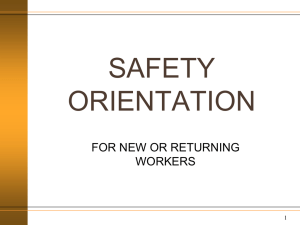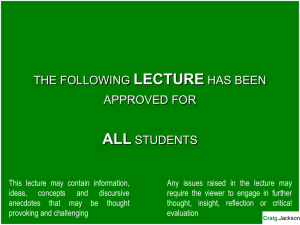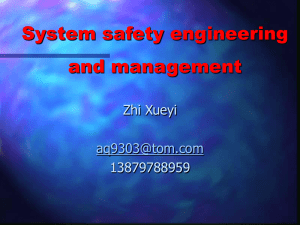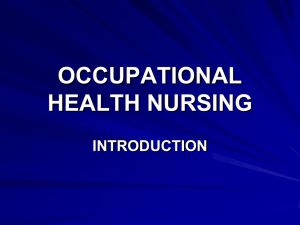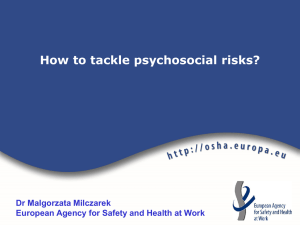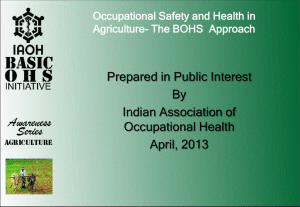stress - Faculty of Health, Education and Life Sciences
advertisement
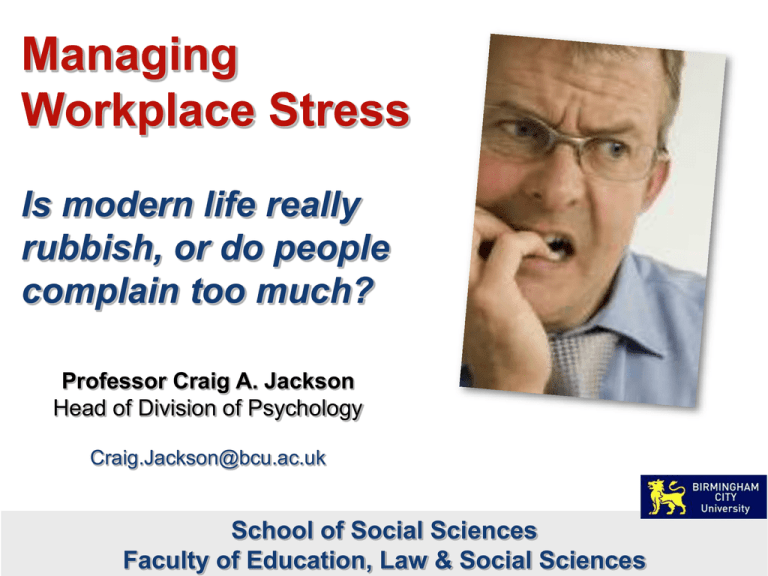
Managing Workplace Stress Is modern life really rubbish, or do people complain too much? Professor Craig A. Jackson Head of Division of Psychology Craig.Jackson@bcu.ac.uk School of Social Sciences Faculty of Education, Law & Social Sciences Psychosocial Hazards •Commonplace consideration in last 5 years •Not straightforward •All workplaces have potential to expose workers to hazards •All social relationships have potential for stress •Little relation between stress and occupational status •Stress-Boom in last 3 years – VERY BIG INDUSTRY “suffering from” & “recognising stress” rapidly increasing issues Workplace Hazards – current status Shiftworking: Long hours: Psychosocial: 1 in 5 employed likely to increase with growth >48 hours per week Fallen due to EWTD Still > most of Europe 5 mill employees perceive effects 13 mill working days lost Mundane occupations suffer Chronic stress more problematic Fatigue Somatic symptoms Sleep MSDs Depression Cardiovascular Accidents Physical: Noise Dust Chemical Vibration Technical Changes Monitoring OELs Depression QoL Negative Affectivity Form of extreme pessimism Hi. I need to see you first thing Monday. It's important. Try to enjoy your weekend. Boss A good sign? A bad sign? Trouble? Stress – The Basics Definition problems Not just at workplace Individual response Work-life Balance Control Demand Stress is not a useful concept: Loose diagnostic criteria Too many triggers Too many responses Too many effect modifiers Used too casually Fashionable Positive perceptions Not reliably measured Personality Cause of many secondary health problems Top 5 UK Workplace Health Problems 1. Hearing loss NIHL, TTS, Exposure 2. Respiratory problems Recycling Asbestosis, Carbon Black, 3. Skin problemsHairdressers, Health care, Engineering 4. Mental health Stress, Anxiety, Uncertainty 5. Musculoskeletal disorders Drivers Desk workers, Cleaners, France Telecom Case Privatised in 1998 40,000 jobs lost since 1998 186,000 employees 45% of those outside France 4.3% fall in profits in 1Q of 2009 182 million customers in 5 continents France Telecom Internationale' 45% of customers outside France 182 million customers in 5 continents France Telecom Suicides 30 staff committed suicide 2008-2009 23 staff committed suicide 2010 French suicide rate: 26.4 per 100,000 male pop 9.2 per 100,000 female pop 17.8 per 100,000 all pop France Telecom Cases 9th Sept: 49 yr old male employee stabbed himself in meeting – told he would be undergoing internal job transfer 11th Sep: 32 yr old female employee leapt to death from office window 14th Sep: 53 yr old senior manager overdosed 1st Oct: 51yr old male employee jumped from road bridge – note blamed work “atmosphere” France Telecom Staff Situation Uncertainty New working conditions Modernisation Internal job transfers - Japanese problem cultural & organisational changes needed France Telecom's 2 Point Defence “There were 28 suicides in the company in 2000, so 23 suicides over 17 months is actually an improvement and not evidence of an epidemic” “Most suicides caused by personal problems not professional ones” High Profile Case 1 2008 Isaac Blake VS Ragdoll Productions “Cold-blooded murder of English Justice” Tombliboo Homophobia , Bullying, Harassment Faulty animatronics - Painful work – hip joints Lost 4 / 5 claims Awarded £2000 for being called a “faggot” twice High Profile Case 2 Armed response officer, aged 37 One of first female snipers in UK 90-strong team (88 males) Hanged at home 2004 2003 Dismissed from firearms duties Complained: •Colleagues viewing porn video on a residential course •Felt victimised in macho culture of firearms unit •Fell out with a number of influential male colleagues Sefton Coroner Christopher Sumner: “Paula Tomlinson killed herself at a time that she was suffering from stress, a contributory factor of which was work related.” Stress Statistics 1995: Labour Force Survey 515,000 reported work-related stress 250,000 attributions of physical symptoms 30% increase in reports since 1990 1996: Institute of Management 270,000 daily absences for stress £10.2 Billion cumulative annual cost (sick pay, lost production, treatment) 2002: UK Health and Safety Executive 265,000 new “cases” in 2001 2000: Evans et al. Scottish heart attack deaths higher on Mondays 2004: UK Health and Safety Executive 13,000,000 working days lost / year -- £12 Billion cost Stress Definitions A. Stress occurs when demands exist which are outside a person’s capacity for meeting those demands B. Stress is a response to the presence of psychosocial hazards in the workplace C. Stress is the reaction people have when they feel they cannot cope with the pressures or demands placed upon them Over-simplistic definitions ! Acute Stress and Chronic Stress Common After-effects Leave behind Life threatening One-off Ever-present By proxy Acute Hazards Work characteristics 1. Potential for violence Accident & Emergency Services 2. Peril or Danger Expected Dangerous Conditions 3. Potential for aggression Hazardous conditions 1. Verbal abuse Ordinary Conditions 2. Physical abuse Unpredictable Behaviour / Incident 3. PTSD inducement Chronic Hazards Job content Work overload / underload Hazardous conditions Under utilisation of skills Time pressures Lack of control Work organisation Shift work Working hours unsociable long unpredictable Work Culture Communication too little (home-working) / too much (email) Change / technology Poor resources No feedback No decision process Chronic Hazards (cont) Work role Ambiguity Conflict Advancement structure Insecurity Promotion under / over Low status Poor pay Environment Hazards physical / chemical Home – work interface Conflicting demands Support Domestic problems Commuting Interpersonal Conflict Colleagues Superiors Subordinates Personal Issues Isolation Lack of support Harassment Bullying Violence . . . Attitudes have changed st 21 Century Satanic Mills When did this happen? NOTICE OUR STAFF HAVE THE RIGHT TO WORK IN AN ENVIRONMENT FREE FROM VIOLENCE We will prosecute anyone found abusing or threatening employees * * This will not affect your treatment Misperceptions of workplaces UK Climate of: over-perception of danger stress being unavoidable wanting too much in return Common Popular Headlines Legal Aspects “Personal Injury” Any impairment or any disease of a person’s physical or mental condition 1974 Health and Safety at Work Act “Assessments of risks of activities associated with potential hazards” 1992 Management of Health & Safety at Work Regulations 1. Johnstone 2. Walker 3. Jones 4. Hurley 5. Fearon 6. Armstrong vs vs vs vs vs vs Bloomsbury H.A Northumberland C.C. Birmingham C.C Gwent Constabulary Martin Home Office Doctor Social Worker Teacher Police officer Burglar Prison warder High Profile Case 3 Andrew Hurley vs Gwent Constabulary Armed Response Unit First on scene of armed robbery – 3 offenders Hurley shot 1. all 3 in custody Won a commendation for the job Resultant stress & depression Left job 5 months later Wanted £250,000 for loss of earnings and pension rights Claimed offered no post-intervention counselling Kept isolated for an hour after event – blood on hands Evidence from Gwent Co. counselling offered 2 months post incident Court of Appeal Guidelines (16 points) Individuals who do not notify their employer of any problems are less likely to succeed in claiming compensation Employers entitled to assume employee can withstand normal jobpressure unless any vulnerability or problem is known No occupations should be regarded as intrinsically dangerous to mental health Employers offering counselling and access to treatment unlikely to be found in breach of duty Employers not in breach of duty if only option is to demote or fire employee, if a willing worker continues in same job Necessary to identify all steps employers (could) have taken before finding them in breach Traditional model of Disease Pathogen Modifiers Lifestyle Individual susceptibility Disease (pathology) Biopsychosocial model of Disease Hazard Psychoscial Factors Attitudes Behaviour QoL Illness (wellbeing) Rise of the worker as a “psychological entity” Psychosocial factors: core of ill-health MSDs Individual vulnerability Personality type Stress Distress Somatics Experience Mental Health Learned behaviours Will workers take responsibility for their ill-health? Historical Errors of Psychosocial View Historically, distress was “blamed” for many ills Now we know better… CHD Cholera Pellagra Beri Beri Asthma Down’s syndrome Scurvy Yellow fever Typhoid Peptic ulcer All believed to be caused by “stress” or “distress” at one time or another Puts “blame” for illness on the person Commuting “Cattle Truck Syndrome” Chronic health problems exacerbated by train travel? Cumulative impact theory Increased B.P, Anxiety, Chronic Heart Conditions Over-crowded trains / buses Straining public transport system Lack of control Commuting "People develop a constant internal anger on crowded trains that they cannot easily displace . . . an individual‘s immune system could also be suppressed by stress, making passengers more susceptible to illnesses” Long Working Hours “Workaholism” “Presenteeism” “Unpaid Overtime” uninterrupted heavy workload heavy physical work excessive demands from irregular overtime and shift work excessive workloads from emotional stress, such as responsibility, transfers, and conflicts • irregular sleep habits • decreases in rest • decrease social time • alcohol abuse • increased smoking • unhealthy diet • neglecting medical checks • breakdown in family life High Profile Case 5 Psychological interventions can work Cromwell Street Murders John Bennett SIO Team of 40 detectives Sought “Stress Counselling” Proactive Some accepted – others did not Before retirement . . . He did a little digging Who has the “bad” jobs? EXTREMELY STRESSFUL Police Fire Ambulance Prison VERY STRESSFUL Civil pilots Media Performers Health care (non-emergency) Social work Teaching Mining Nursing Construction ABOVE AVERAGE STRESS Marketing Publishing Printing Retail Catering Transport HOW MUCH FAITH CAN BE PUT INTO BROAD CATEGORIES? Cooper 1988 Some Stress is good Keeps one alert Keeps one alive Evolutionary perspective: Too little stress = extinction Too much stress = extinction Balance stress = evolution Pressure is good - - Stress is bad Admissions and World Cup 1998 Examine hospital admissions for range of diagnoses on days surrounding England's 1998 World Cup football matches Hospital admissions obtained from English hospital episode statistics Pop. Aged 15 – 64 years Admissions for • Acute MI On match day • Stroke and 5 days after • Deliberate self harmmatch day • Road traffic injuries Compared with admissions at the same time in 1997 and 1998 Carroll, D et al. 2002 Admissions and World Cup 1998 Major environmental events, whether physical catastrophes or cultural disappointments, are capable of triggering myocardial infarction. If the triggering hypothesis is true, preventive efforts should consider strategies for dealing with the effects of acute physical and psychosocial upheavals. “Perhaps the national lottery or even the penalty shoot-out should be abandoned on public health grounds.” Limitations: Harvesting effect? Reporting tendency? Sudden deaths? Iatrogenesis Induced inadvertently by the medical treatment or procedures or activity, examination, manner or discussion of a physician. The term is now applied to any adverse condition in a patient occurring as the result of treatment by a physician or surgeon, (e.g. acquired infections) A disease produced as a consequence of medical or surgical treatment. Common Coping Styles Adaptive coping Seek those with similar experiences Confront issue Stick to a plan of action Support seeking Day to day basis Change situation Seek information •LONG •TERM •STRATEGY Maladaptive coping Withdraw from people in general Avoidance Deny what has happened Consumption Drink, eat, smoke to relieve tension Denial •SHORT •TERM •STRATEGY Individual Variability / Vulnerability Differing Attitudes & Differing perceptions Natural differences Complex reasons Experience Personality Learned behaviours Stress is associated directly with workplaces BUT is also mediated by individual differences No universal profile of what will certainly constitute stressful situations Vulnerable People Important to be aware of vulnerable individuals and groups Associated with socio-economic, cultural or demographic status Females Immigrant workers Disabled Excluded groups Ethnic minorities Any group by definition which is un-empowered Personality although some of this is spurious! “Type A” (uptight, goal oriented) likelihood of stress-illness and CHD “Type C” (high anxiety) likelihood of Cancer “Type D” (negative affectivity, emotional inhibition) likelihood of CHD “External” locus of control à poorer at handling stress “Hardiness” à greater resistance and operability Karasek’s demand-control model high Productive, Motivated active passive high strain low job control low strain low high job demands 1979 Risk of psychological strain and increased illness Summary of Occupational Stress Any workplace / person / social interaction Stress is a natural / healthy response Some responses to stress are pathological Worker intolerance Impossible to predict stress reliably – easier to predict intolerance Individual modifiers – personality, behaviour, coping style, perception Legal obligation clearer than ever Psychosocial hazards unavoidable & intrinsic in some cases Most psychometric stress testing unethical Recommended Reading Carroll D, Davey Smith G, Sheffield D, Shipley MJ, and Marmot MG. Pressor reactions to psychological stress and prediction of future blood pressure: data from the Whitehall II study. BMJ 1995;310:771-775. Chen C, David AS, Nunnerley H, Michell M, Dawson JL, Berry H, Dobbs J, and Fahy T. Adverse life events and breast cancer: case-control study. BMJ 1995; 311: 1527-1530. Jackson CA and Cox T. Health and well-being of working age people. ESRC Seminar Series. ESRC. London. 2006 Jackson CA. Psychosocial Aspects of the Workplace. In Aw, T.C et al. (eds) Occupational Health Pocket Consultant (fifth edition). Oxford: Blackwell Scientific Publishing; 2006. 191201 Jackson CA. Psychosocial Hazards. In Smedley, J et al. (eds) Oxford Handbook of Occupational Health. Oxford. Oxford University Press; 2007. 167-179 Karasek R. Jobs demands, job decision latitude and mental strain : implication for job redesign, Administrative Science Quarterly 1979, 285-308. Recommended Reading Kivimäki M, Leino-Arjas P, Luukkonen R, Riihimäki H, Vahtera J, and Kirjonen J. Work stress and risk of cardiovascular mortality: prospective cohort study of industrial employees. BMJ 2002; 325: 857. Lees, R., and Laundry, B.R. Comparison of reported workplace morbidity in 8-hour and 12hour shifts in one plant. Journal of the Society of Occupational Medicine (1989) 39. Levenstein S. Stress and peptic ulcer: life beyond helicobacter. BMJ 1998; 316: 538-541. Lodden, T., The Effect on the Health and Safety of Older Offshore Personnel - Long Shifts and Working Night Shift. Society of Petroleum Engineers. SPE 60996. Parkes, K.R.: Sleep patterns, Shift work, and Individual Differences: A Comparison of Onshore and Offshore Control-Room Operators. Ergonomics (1994) 37(5). Shain M and Kramer DM. Health Promotion in the Workplace: Framing the Concept; Reviewing the Evidence. Occupational and Environmental Medicine 2004;61:643-648. Recommended Reading Rosa, R.R: Performance, alertness, and sleep after 3.5 years of 12 hour shifts: a follow-up study. Work and Stress (1991) 5(2). Spurgeon A, Harrington JM, Cooper CL. (1997) Health and safety problems associated with long working hours: a review of the current position. Occup Environ Med; 54:367-375. Work Stress: The Making of a Modern Epidemic. Michael Fitzpatrick. Open University Press, 2002.

